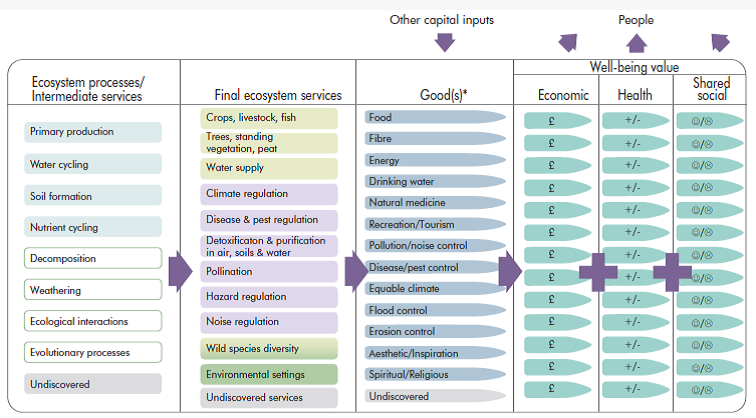Recent reports1 have highlighted the continued decline in species and habitats across the world. One of the reasons that we fail to use the natural environment in a sustainable way is because the benefits we receive from nature are not always as obvious as the benefits from economic development. It is also very difficult to make decisions about how to use our natural resources when the environmental, social and economic changes that would result from particular actions are all measured in different ways. The ecosystem services concept arose to try to address this problem by providing a common language and a transparent framework for decision-making.
The ecosystem services approach looks at the natural world in terms of how it provides the things people need and want. Some of these benefits are quite obvious (food, raw materials and opportunities for recreation, for example) but others are less so, such as the role of the environment in controlling pollution and flooding and in maintaining our physical and mental health. The ecosystem services approach attempts to better communicate the connection between human wellbeing and ecosystems by linking the benefits that we obtain back to the environmental processes that provide them. The concept is often thought of as a cascade:

The ecosystem services ‘cascade’2
Works in the late 1990s led by Gretchen Daily3 and Robert Costanza4 were significant in drawing attention to the ecosystem services concept and its applications. Another milestone was the publication of the Millennium Ecosystem Assessment5, which had been commissioned by the United Nations. This developed a classification framework for ecosystem services, which has since been widely used. The framework classified ecosystem services into four types: provisioning services (food, genetic resources and other raw materials), regulating services (such as climate regulation and water purification) and cultural services (which include recreation, education and cultural heritage). The fourth type, supporting services, contains those services such nutrient cycling and primary production, upon which the production of all other ecosystem services depend.

Table1: The four types of services proposed by the Millennium Ecosystem Assessment
Ultimately, the ecosystem services approach is about value: it is about showing how important the environment is in our daily lives. Describing the value of environmental benefits in monetary terms can help when making trade-offs between ecosystems and economic development, such as weighing up whether the job creation and increased tourism that would result from the construction of a ferry port is worth more than the environmental costs including disturbance to, and mortality of, marine life, loss of habitat, and changes to currents and sediment behaviour. This concept of the economic contribution of nature was central to another global programme, The Economics and Ecosystems and Biodiversity (TEEB)6 , which followed the Millennium Ecosystem Assessment and further developed the ecosystem services concept.
However, it may not be possible to fully express the contribution nature makes to our wellbeing in purely monetary terms. This was recognised by UK National Ecosystem Assessment (UK NEA)7, a programme that aimed to provide a comprehensive picture of the UK’s ecosystem services and their value. The UK NEA framework explicitly highlighted the potential health and social benefits of nature alongside the economic value.
 Table 2: The framework proposed by the UK National Ecosystem Assessment
Table 2: The framework proposed by the UK National Ecosystem Assessment
The ecosystem services concept continues to evolve. In particular, more work is needed to determine the value of all the different benefits we receive from nature. Also, we need to better understand what it is we need to measure so that we can effectively monitor changes in ecosystem services, and so improve the management of our natural resources. There are particular gaps in our knowledge concerning the links between ecosystem services and the underlying biological functions and processes, and also in how to measure and report the cultural benefits we receive from nature. The work being undertaken in VALMER will contribute to the further development of the ecosystem services concept and its practical application.
Notes
1 Some examples:
http://www.cbd.int/gbo3/?pub=6667§ion=6673; http://www.rspb.org.uk/ourwork/science/stateofnature/
2 Adapted from Haines-Young, R. and Potschin M. 2010. The links between biodiversity, ecosystem services and human well-being. Ch6. In: Raffaelli, D. and Frid C. (Eds.): Ecosystem Ecology: a new synthesis. BES ecological reviews series, Cambridge University Press, Cambridge (31 pp)
3 Daily, GC, Ed. 1997. Nature’s Services: Societal Dependence on Natural Ecosystems, Island Press, Washington, DC.
4 Costanza R, d’Arge R, de Groot R, Farber S, Grasso M, Hannon B, Limburg K, Naeem S, O’Neill R.V, Paruela J, Raskin R.G, Sutton P and van den Belt M. 1997. The value of the world’s ecosystem services and natural capital. Nature 387: 253-260
5 http://millenniumassessment.org/en/About.html
6 http://www.teebweb.org/about/

 English
English  Français
Français 













